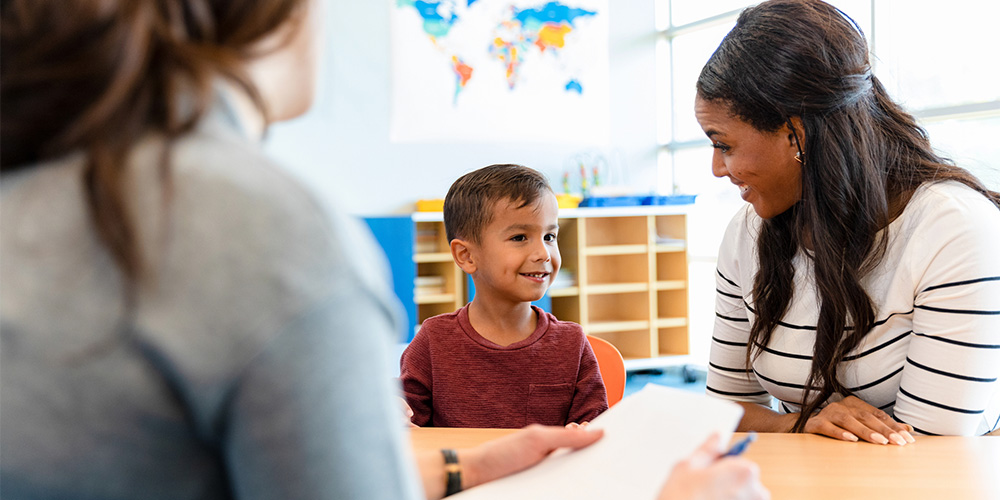In the most utopian scenario, the parent–teacher partnership would consist of two parties acting in harmony to carve out a brighter future for a young person. With a foundation in respect, open-mindedness, and fluid communication, the successful teacher–guardian relationship ought to be a driving force that propels a child’s education forward.
But this isn’t exactly an ideal world, is it?
If we’re being honest, the teacher–parent relationship is sometimes more adversarial than collaborative, though such antagonism is often reversible. That’s why we’ve created this blueprint for creating a successful parent–teacher partnership.
Questioning as a Foundation for Growth
As much as teachers care for their students, it’s safe to say that parents know their children best. When it comes to emotional, social, and academic needs, a child’s guardian can provide the clearest picture of how teachers can tailor their pedagogy to maximize positive outcomes. That’s why asking questions is crucial to building a cooperative partnership.
While not every parent will give teachers a novel-length description of their kid’s station in life, some basic, open-ended questions can create an ongoing and persistently fruitful conversation. For example:
- What would you like Jenny to get out of this school year?
- Does Tarik have any academic strengths we should leverage in the classroom?
- Is there anything about last year you’d like to see improve this time?
- Does Olivia have any specific interests or hobbies that we can use as a learning tool?
- How can I best support Cayden?
The Importance of Setting Clear Goals
It should be clear that teachers enter the classroom every day with the most magnanimous plans at heart. (You have to be a saint to take on this challenging job, after all.) But unfortunately, despite your status as an angelic do-gooder, parents don’t always understand your mission. Therein lies the importance of explicitly expressing your positive intentions. It’s paramount to create clear goals based on the information you have about each student who walks through your door.
Does anyone expect you to know the ins and outs of every kid’s unique position? Of course not. But if you’ve asked the right questions, you have a guiding light to help you set clear goals. To that end, we recommend the tried-and-true system of SMART goal setting:
- Specific objectives based on the needs of the child
- Measurable and assessable milestones that track progress
- Achievable progress based on strengths and weaknesses
- Realistic outcomes confined by abilities and constraints
- Time-bound completion that maintains focus on the goals
Proactive and Frequent Communication
It’s one thing to send out an introduction letter, the old teacherly standard that sets a positive tone and expectations for the year ahead. But communication must be consistent throughout the year, regardless of whatever academic shifts and social or behavioral turbulence occurs. Not only that, when it comes to forming a partnership based on shared goals, it’s crucial to address issues before they become severe.
Especially as it pertains to disciplinary concerns, proactivity is the differentiator between a learning opportunity and a persistent problem. Look for the causes of misbehavior that you can discuss with the parent, which may include the following:
- Yearning for attention: Whether we like it or not, craving attention is a common human behavior, and despite their innocence, children are not immune. The cause does not stem from a negative place, but the behaviors are nevertheless causing a distraction.
- Testing authority: It’s natural to want increased autonomy and independence, especially as we get older and gain a more intricate sense of self. Again, this does not necessarily give cause for concern, but small disciplinary infractions might become more distracting if not addressed.
- Addressing perceived injustices: OK, it’s tough being a kid. Let’s not forget that. When you’re young, your emotions often feel more acute, especially if you don’t get your way. Of course, this feeling may lead to outbursts and negative actions. If you’re aware of the emotional catalyst, then you can communicate that dynamic to the parent.
- Lamenting shortcomings: Failure is part of life. It’s a learning experience, really. But sometimes, that progress-in-action translates to feelings of inadequacy that manifest into lashing out or giving up. If you can identify this as a root cause, you can work together with the child’s guardian to stave off negative feelings that lead to misbehavior.
The Power of the Positive Phone Call
Do you know how much it stinks to only hear criticism? Doesn’t it feel pretty crappy to only hear about the stuff you do wrong? This explains the power of the positive phone call, which really doesn’t require much explanation.
If you see a kid stand up for a crying classmate, offer a hand to someone who’s fallen on the playground, work hard to overcome an obstacle, thank a cafeteria worker for their help, pick up garbage on their own volition, or perform any act of human decency, you better believe a parent will appreciate hearing about it.
Benefits of a Positive Parent–Teacher Partnership
Parental involvement means learning doesn’t stop when a child transitions from the classroom to their living room. That parent–teacher partnership, if it’s successful, means that a child knows that more than one adult believes in them and has a stake in their future. In turn, this reality translates into a host of benefits, including:
- Enhanced academic progress founded on open communication that buoys existing strengths and mitigates obstacles
- Greater social-emotional growth that goes beyond the classroom and home life
- An established connection between schools and the communities they serve
- More resources in the classroom, from volunteer help and donated supplies to heightened academic progress that leads to more funding
- A streamlined year for teachers who can rely on parents’ good nature and willingness to work on issues in the classroom







